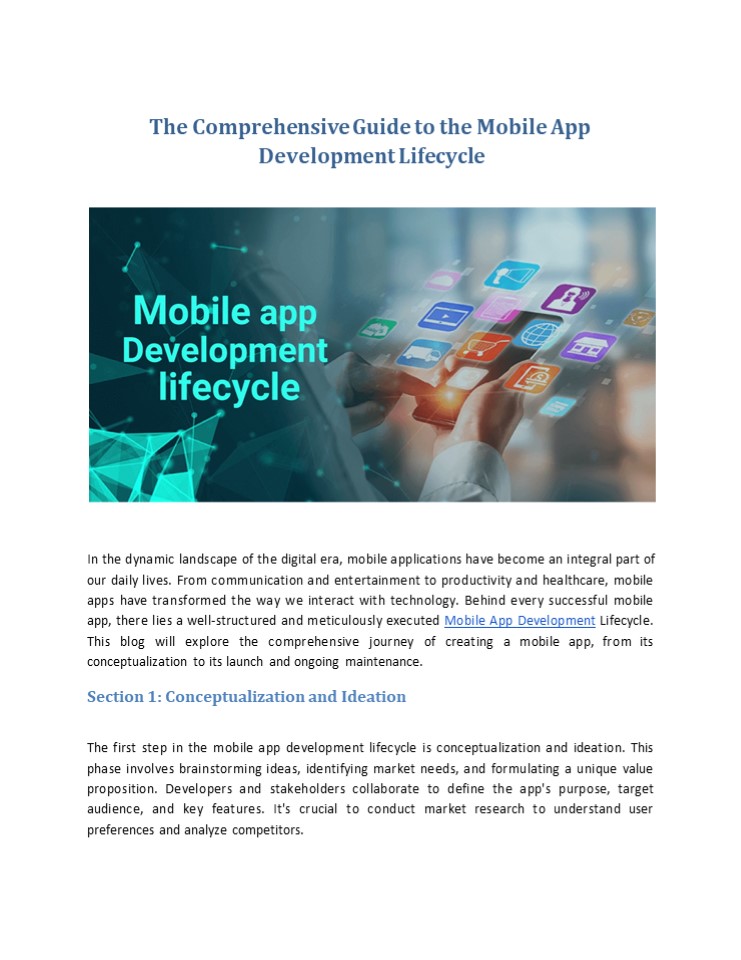The Comprehensive Guide to the Mobile App Development Lifecycle - PowerPoint PPT Presentation
Title:
The Comprehensive Guide to the Mobile App Development Lifecycle
Description:
In the dynamic landscape of the digital era, mobile applications have become an integral part of our daily lives. From communication and entertainment to productivity and healthcare, mobile apps have transformed the way we interact with technology. Behind every successful mobile app, there lies a well-structured and meticulously executed Mobile App Development Lifecycle. This blog will explore the comprehensive journey of creating a mobile app, from its conceptualization to its launch and ongoing maintenance. – PowerPoint PPT presentation
Number of Views:2
Title: The Comprehensive Guide to the Mobile App Development Lifecycle
1
The Comprehensive Guide to the Mobile App
Development Lifecycle
In the dynamic landscape of the digital era,
mobile applications have become an integral part
of our daily lives. From communication and
entertainment to productivity and healthcare,
mobile apps have transformed the way we interact
with technology. Behind every successful mobile
app, there lies a well-structured and
meticulously executed Mobile App Development
Lifecycle. This blog will explore the
comprehensive journey of creating a mobile
app, from its conceptualization to its launch and
ongoing maintenance. Section 1 Conceptualization
and Ideation The first step in the mobile app
development lifecycle is conceptualization and
ideation. This phase involves brainstorming
ideas, identifying market needs, and formulating
a unique value proposition. Developers and
stakeholders collaborate to define the app's
purpose, target audience, and key features. It's
crucial to conduct market research to understand
user preferences and analyze competitors.
2
During this stage, the feasibility of the app is
assessed, taking into consideration technical
requirements, budget constraints, and potential
challenges. Developing a solid concept and clear
objectives lays the foundation for a successful
mobile app development journey. Section 2
Planning and Strategy Once the concept is
defined, the next phase involves planning and
strategy. This step includes outlining the
project scope, creating a timeline, and
determining the budget. The Software Development
Company Project managers collaborate with
developers, designers, and other stakeholders to
establish milestones, allocate resources, and
define the technology stack. A crucial aspect of
this phase is creating a Minimum Viable Product
strategy. The MVP allows developers to release a
basic version of the app with essential features,
gather user feedback, and make iterative
improvements. This iterative approach minimizes
risks and ensures that the final product aligns
with user expectations.
Section 3 Design and Prototyping The design and
prototyping phase focuses on creating the user
interface (UI) and user experience (UX) design.
Designers work closely with developers to
translate the conceptualized ideas into visual
elements that resonate with the target audience.
Wireframes, mockups, and prototypes are created
to provide a tangible representation of the
app's layout and functionality. User feedback
is crucial during this phase to refine the design
and ensure a seamless user experience.
Accessibility and usability are given high
priority to cater to a diverse user base. The
final design should not only be visually
appealing but also intuitive and
user-friendly. Section 4 App Development With a
solid plan and design in place, the development
phase kicks off. Developers start coding the app
based on the specifications outlined in the
planning phase. The choice of programming
languages, frameworks, and development tools
depends on the platform (iOS development, Android
development, or cross-platform) and the app's
requirements. Agile or Scrum methodologies are
often employed during the development phase to
facilitate collaboration, flexibility, and
quick adaptation to changes. Continuous
integration and
3
continuous delivery (CI/CD) practices are
implemented to streamline the development process
and ensure a stable and scalable product. Testing
is an integral part of the development phase.
Quality Assurance (QA) teams conduct various
tests, including functional, performance,
security, and compatibility testing, to identify
and rectify bugs and issues. Regular testing
ensures a high-quality app that meets industry
standards. Section 5 Testing and Quality
Assurance The testing and quality assurance
phase is critical to delivering a reliable and
bug-free mobile app. Various testing methods are
employed to validate the app's functionality,
performance, security, and compatibility across
different devices and operating systems.
Automated testing tools are often utilized to
streamline the testing process and identify
potential issues efficiently. User acceptance
testing (UAT) is conducted to gather feedback
from real users and make final refinements before
the app's launch. A rigorous testing process
contributes to a positive user experience and
minimizes the risk of post-launch issues. Section
6 Deployment The deployment phase involves
launching the app to the public. Developers
prepare for the app store submission process,
ensuring compliance with the respective
platform's guidelines and regulations. Submission
materials, such as app descriptions, screenshots,
and promotional materials, are prepared to
optimize the app's visibility in the app
store. Once approved, the app is officially
released, making it accessible to users
worldwide. Launching the app marks a significant
milestone, but the development lifecycle doesn't
end here. Section 7 Post- Launch Maintenance and
Updates Post-launch support and maintenance are
crucial for the long-term success of the mobile
app development agency. Regular updates are
released to address user feedback, fix bugs, and
introduce new features. Monitoring user reviews
and analytics helps identify areas for
improvement and future enhancements.
4
Security updates are paramount, considering the
evolving threat landscape. Continuous monitoring
of the app's performance, server stability, and
user engagement metrics ensures a seamless user
experience. Conclusion The mobile app
development lifecycle is a comprehensive and
iterative process that involves collaboration
among various stakeholders. From the initial
conceptualization to the ongoing post-launch
support, each phase plays a vital role in
delivering a successful and sustainable mobile
app. By adhering to best practices, embracing
user feedback, and staying abreast of
technological advancements, developers can
navigate the complexities of the mobile app
development lifecycle and create innovative
solutions that resonate with users
worldwide. In the ever-evolving world of mobile
technology, the ability to adapt and refine the
development process is key to staying competitive
and delivering impactful mobile applications.































